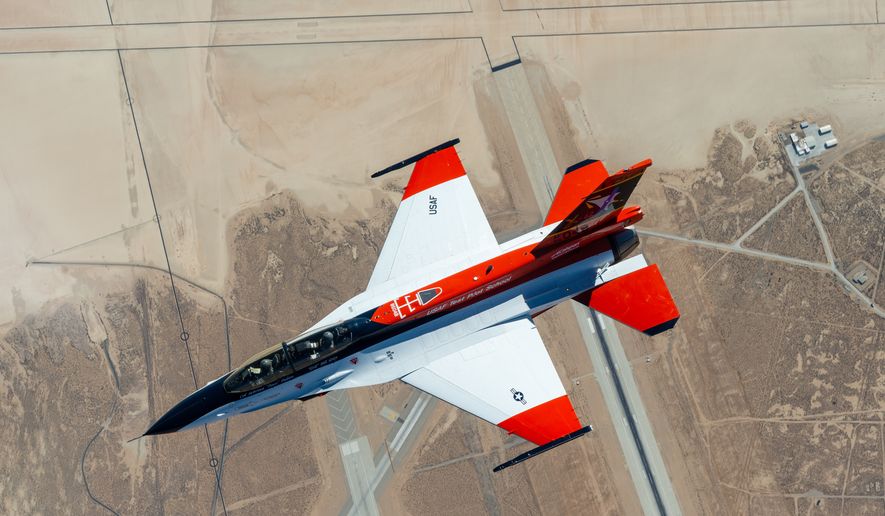A version of this story appeared in the daily Threat Status newsletter from The Washington Times. Click here to receive Threat Status delivered directly to your inbox each weekday.
The U.S. military said it has completed the first “AI dogfights” pitting a manned F-16 against an aircraft controlled by artificial intelligence in the skies above Edwards Air Force Base in California.
The experimental X-62A aircraft, whose controls were operated by cutting-edge AI technology, traveled at speeds of 1,200 mph and came within 2,000 feet of its human opponent in the F-16, the Air Force Research Laboratory said.
Frank Kendall, secretary of the Air Force, called the encounter a “transformational moment” as the military announced the breakthrough accomplishment this month by the U.S. Air Force Test Pilot School and the Defense Advanced Research Projects Agency.
“The potential for autonomous air-to-air combat has been imaginable for decades, but the reality has remained a distant dream up until now,” Mr. Kendall said in a statement. “In 2023, the X-62A broke one of the most significant barriers in combat aviation.”
The X-62A VISTA aircraft is effectively an F-16 with technology akin to an entire flight simulator laboratory crammed into it, according to a DARPA video released this month.
Although human pilots were in the aircraft throughout the AI dogfighting, the human pilot never flipped a safety switch to take control of the aircraft, DARPA said.
Que Harris, then working as Lockheed Martin X-62A lead flight controls engineer, said in DARPA’s video that the aircraft has an integrated space allowing flight controls to receive commands from AI agents.
“The incredible accomplishment of this year was to take these machine-learning agents and place them into the X-62 in a real-world environment,” Col. James Valpiani, commandant of the Test Pilot School, said in the video.
AI agents first controlled the flight path of a fighter aircraft in December 2022. The team working on the experimental aircraft then began incorporating other AI agents, retrained them daily and reprogrammed the flights overnight.
In September, the X-62A flew against a manned F-16 for the first time.
“We built up in safety using the maneuvers: first defensive, then offensive, then high-aspect, nose-to-nose engagements,” Lt. Col. Maryann Karlen, Test Pilot School deputy commandant, said in DARPA’s video.
Neither the Air Force Research Laboratory nor DARPA said whether the machine or man prevailed in the sky.
DARPA’s video said an AI agent previously pitted against a human pilot in a simulator “ended up sweeping all five matches, defeating the human in that case.” The AI in the simulator, however, had not yet been trained to adhere to rules that keep pilots safe.
The team working on the X-62A’s systems made more than 100,000 lines of flight-critical software changes across 21 test flights, the Air Force Research Laboratory said.
“We have to be able to trust these algorithms to use them in a real-world setting,” said Lt. Col. Ryan Hefron, DARPA program manager.
The Air Force said Mr. Kendall will soon take flight in the X-62A to witness the AI in a simulated combat environment. Air Force spokeswoman Ann Stefanek said The Washington Times will be blocked from covering the secretary’s forthcoming voyage in California because of space constraints, though other news outlets will be allowed to attend.
• Ryan Lovelace can be reached at rlovelace@washingtontimes.com.




Please read our comment policy before commenting.